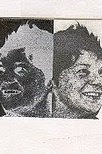 Image size: 16" x 24" approx.
Image size: 16" x 24" approx.Paper: Mulberry
Edition: 5
Mixed Media: Found grained wood block center piece, and the 'Dry lithography' *technique, (impressions of wood grain cut out to create faux wood impressions).
*'Dry Lithography' was a technique using a toxic chemical that eventually was taken off the market - the term thus dubbed by artist, Bebe Dushey, who devoted the latter part of her life to producing 30" x 40" expressionist works, taught by the inventor, Harry Hoehn.
In 1973 Professor Harry Hoehn of C.W.Post, Long Island, published the "trouble-free" lithographic technique that he invented and taught. (Full text: American Artist and Crafts Horizon magazines, with illustrations by Harry Hoehn and James Lewiki).
The invention was based on the idea that oil and water do not mix, using a silicone product, then known as Dispersion #236 which, when applied to a dry surface, would reject lithographic ink. It was not meant to replace the lengthy traditional lithographic process, but to provide the artist with a similar effect with much less trouble.
UPDATE:
Since then, sensitized plates for new approaches to making prints have been manufactured, including the more successful etching SOLARPLATE technique, invented by Dan Welden of Long Island. Dan will be exhibiting a big show of his work for the next two months at Adelphi University, Garden City, Long Island.











Lovely! A pebble has been thrown into the water and what was a still glasslike sheet has revealed everything below, just for a second. You've achieved shadow and reflection, I think, and I really like it.
ReplyDeleteAmazing! it reminds me of what you were doing with the reflective photos, the ones of shop windows with the reflections of the city streets. Like two completely separate fields amassing to create one composition. Can't wait to see what's coming next!
ReplyDeleteSuch very subtle and lovely colors.
ReplyDeleteLook forward to the story of the toxic paint........